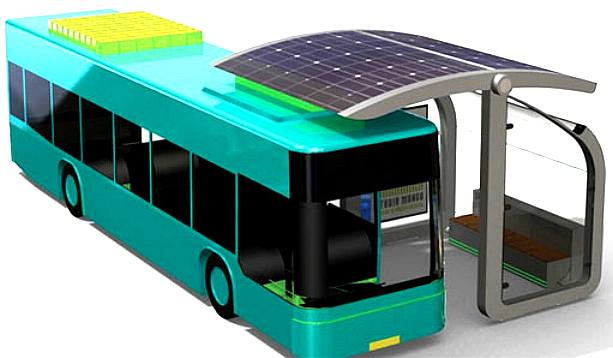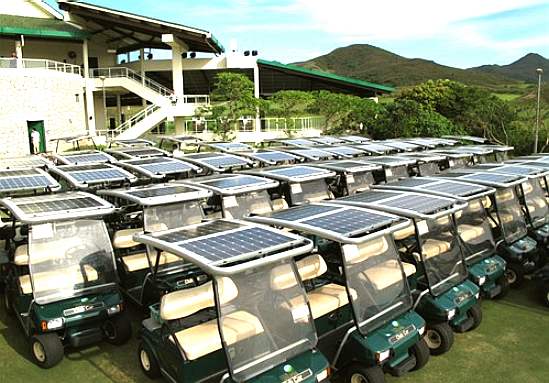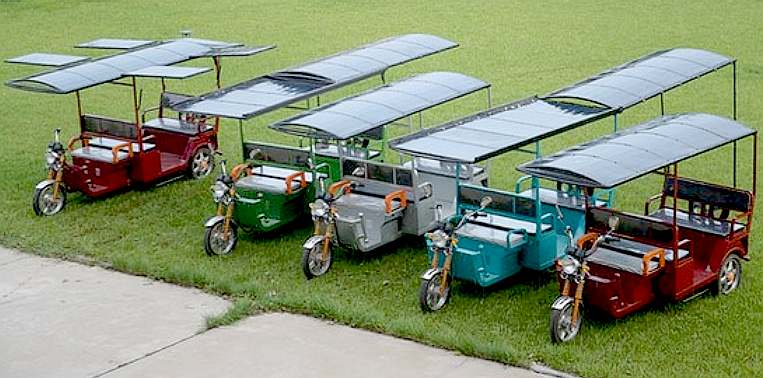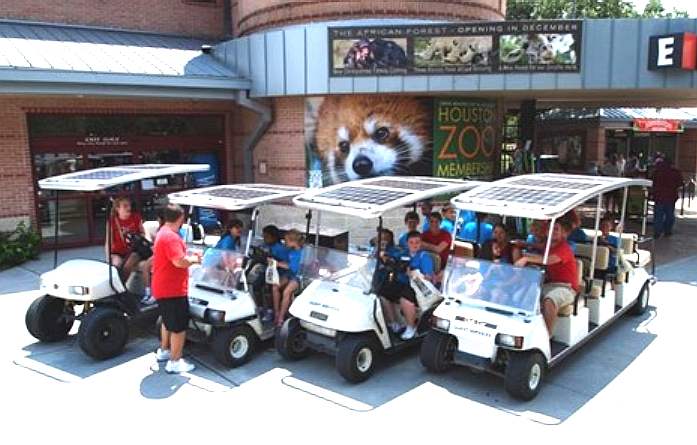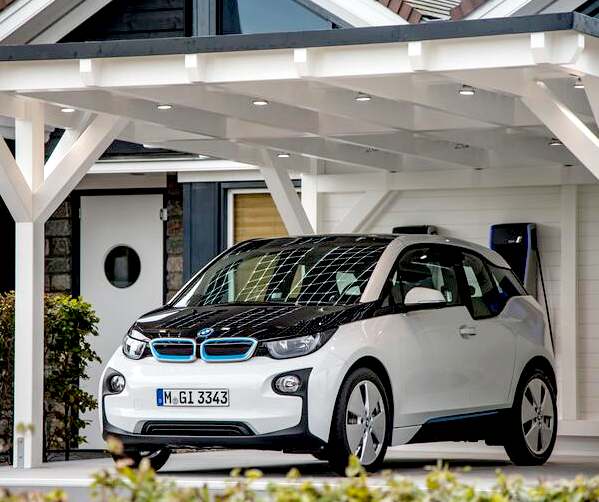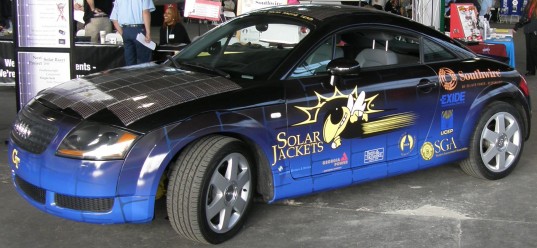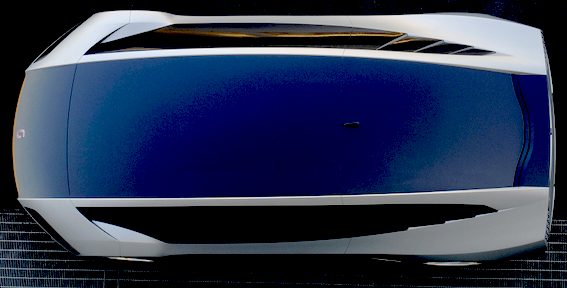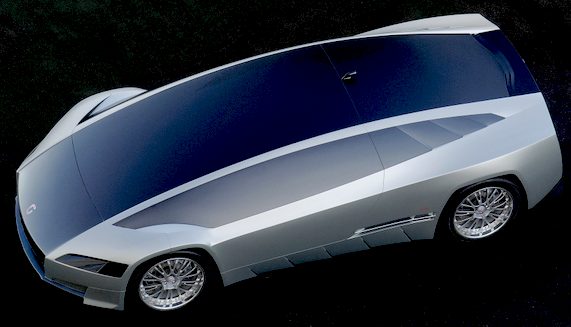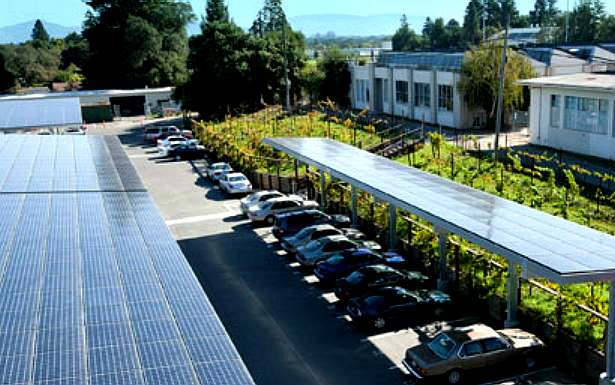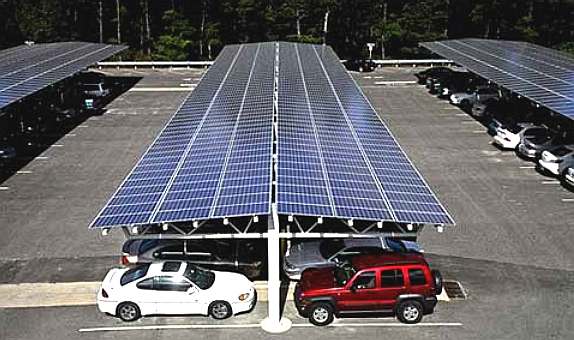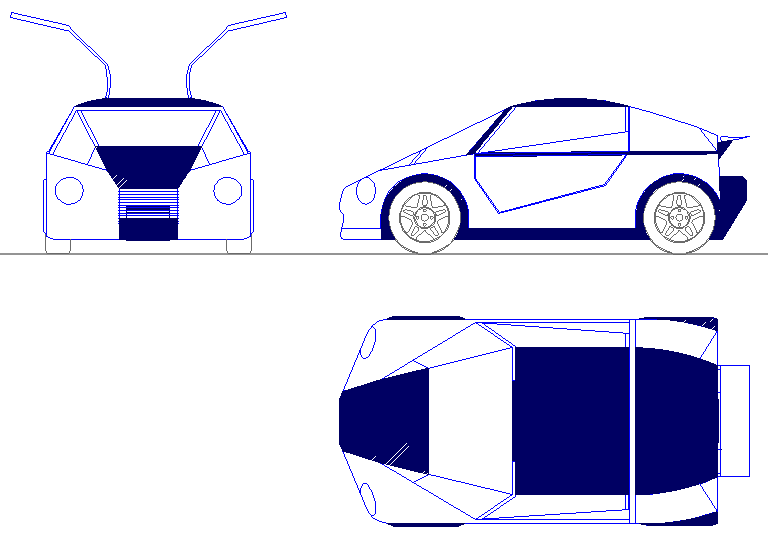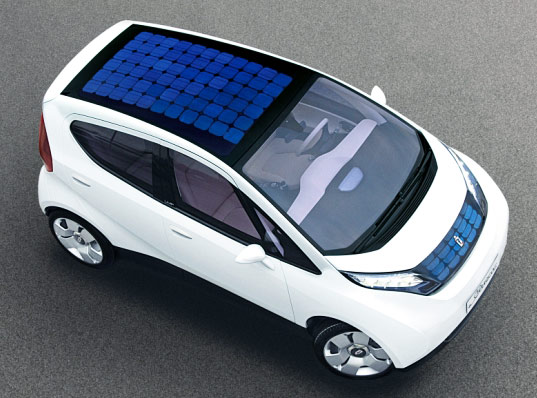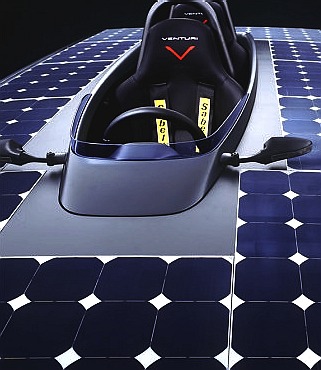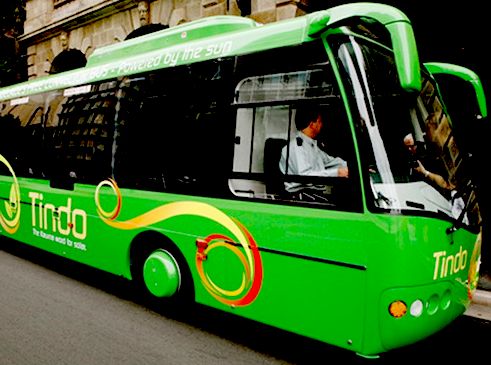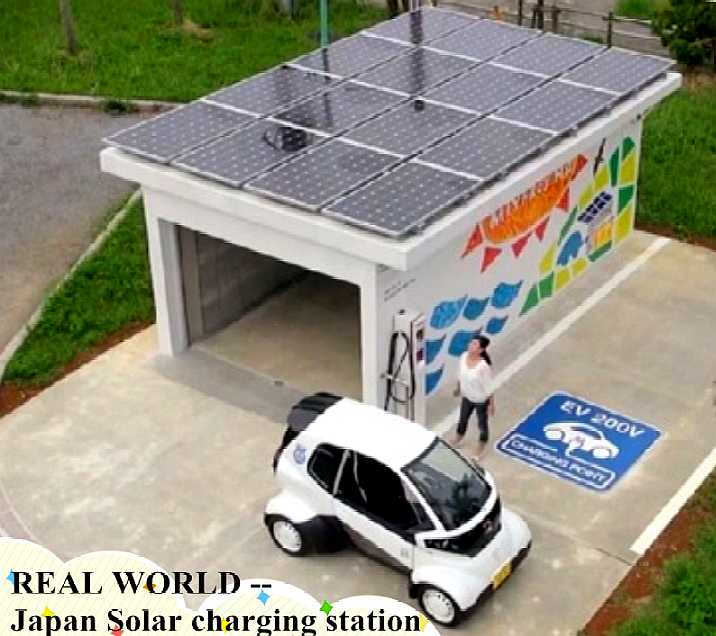|
SOLAR ASSISTED VEHICLES - SOLAR DRIVE
|
|||||||||||||||||||||||||||||||||||||||||||||||||||||||||
|
This concept is for bus stops that have solar roofs that charge buses wirelessly as they take on board passengers. Not a bad idea. Truck stops could use similar technology, but swap energy cartridges - a necessary innovation, as they cover longer distances between stops.
The technology exists to run all of the vehicles on the road today from renewable energy by 2030. Unfortunately, that would mean adapting newly made vehicles to include a storage medium that allowed extremely fast energy exchanges, in electrical and liquid forms and interchangeability between the energy sources. It would also mean building supporting structures for PV panels in car parks, etc. We would advocate making that a planning priority in terms of gain, as an incentive to developers.
One exception to RE in the short term might be HGVs and other long distance truck-chassis based vehicles (coaches, buses), where the industry innovation and acceptance cycle is sure to be far longer, and the energy storage systems more bulky. But that is only in the short term. 2050 might be a realistic target here, unless the present floods and storms reach such a peak that politicians everywhere implement emergency development programs, such as during wartime - when commercial competition rules would not longer apply.
In 1995 the forward thinking British energy supply company Powergen, were interested in investing in and developing a patent battery cartridge exchange system for roadside (bus stop) charging. If the development of that system had gone ahead we would be streets ahead by now. Negotiations though, faltered and Powergen ceased to exist as an entity shortly thereafter.
SOLAR BUS
A solar bus or solar-charged bus is a bus which is powered exclusively or mainly by solar energy. A solar-powered bus service is referred to as a
SBS. The use of the term "solar bus" normally implies that solar energy is used not only for powering electric equipment on the bus, but also for the propulsion of the vehicle.
After three years in service the SolarDrive powered Club Cars at The Jockey Club Kau Sai Chau Public Golf Course have proven their worth resulting in substantial extended battery life. How long the batteries will live is difficult to determine at this point, as the battery packs still shows good shape after 3 years in service. Before going solar, according to the club management they used to exchange batteries after just 18 months. On top the club have enjoyed significant savings in electricity costs for traditional charging. Initially Kau Sai Chau decided for equipping 205 of their existing Club Car Precedents at the Golf Course with the newly released SolarDrive S2E solar power unit. At the time of the investment the club management had high expectations for this technology and they were not let down. Already when the first year had past it was decided to extend the use of solar power to the fleet of 4 and 6-person cars at the Jockey Club. Cameron Halliday, General Manager at KSC, shares his experiences in a letter to Solar Drive.
SOLAR & SOLAR-ONLY E BUS SERVICES
(SBSs)
SBS USE IN AUSTRALIA
Star 8 in Australia have designed a solar powered electric auto-rickshaw known as a SolarTuk. The lightweight vehicles have their roofs fitted out with solar panels and two storage batteries, one for powering the motor and the other for storing solar energy. Currently, traditional auto rickshaws are powered by petrol. According to Star 8 director Jacob Maimon, many families can’t afford the cost of petrol so they fill up small amounts after each trip. The SolarTuk should be able to curb this problem. The SolarTuk will cost somewhere between $2,000 – $3,000. Star 8 have already begun production discussions in China, India, Bangladesh, Vietnam, the Philippines, South Africa and Nigeria. Star 8 is in the process of building a factory in Cambodia.
In May 2013, the NRG and Reliant team joined with Houston Zoo's facilities staff to retrofit one of the Zoo's four-seater electric golf carts to solar power, making it the Zoo's first Solar Powered Electric Vehicles. In August, SolarDrive, Apache Golf Cars and Hollins Enterprises, assisted the Houston Zoo in the installation of Solar Powered roofs on the next four electric golf car vehicles in a series of many to come. Due to the modular concept of the SolarDrive S2E roof Houston Zoo gets maximum flexibility in fitting the modules they have acquired. The four carts chosen this time were an E-Z-GO Shuttle six-seater, a Club Car Villager eight-seater, an E-Z-GO ST, and a Carry All 6 maintenance vehicle. The SolarDrive S2E roofs were 200, 300 and 400 Watt versions. The two-year conversion program for the Houston Zoo's electric vehicle fleet to SolarDrive S2E at the Houston shows the Zoo's community leadership in the use of alternative sources of energy in its daily operations.
SOLAR TAXIS
A Swiss project, called "Solartaxi", has circumnavigated the world. This is the first time in history an electric vehicle (not self sufficient solar vehicle) has gone around the world, covering 50000 km in 18 months and crossing 40 countries. It is a road-worthy electric vehicle hauling a trailer with solar panels, carrying a 6 m² sized solar array. The Solartaxi has Zebra batteries, which permit a range of 400 km without recharging. The car can also run for 200 km without the trailer. Its maximum speed is 90 km/h. The car weighs 500 kg and the trailer weighs 200 kg. According to initiator and tour director Louis Palmer, the car in mass production could be produced for 16000 Euro. Solartaxi has toured the World from July 2007 till December 2008 to show that solutions to stop global warming are available and to encourage people in pursuing alternatives to fossil fuel. Palmer suggests the most economical location for solar panels for an electric car is on building rooftops though, likening it to putting money into a bank in one location and withdrawing it in another. Solar Electrical Vehicles is adding convex solar cells to the roof of hybrid electric vehicles.
SOLAR DRIVE CONTACTS
STUMBLING BLOCKS TO MARKET ACCEPTANCE
Ask any motorist and they'll tell you that the only reason they don't trade in their petrol cars for pure clean EVs is the range limitation of currently available models.
Hybrids are one possible answer to the transition problem, but these too are not equipped with the all essential cartridge system to be able to take the next step. We would like to see all motor manufacturers agree a universal format to prevent a format war in the future which will inevitably see consumers losing out at some stage.
The invitation is to all manufacturers to design a prototype EV with a battery cartridge exchange system built in. It's not difficult, our design consultant produced two loading systems in his home garage by hand. The technology exists but will need to be adapted and refined by each manufacturers' engineers for their own vehicles. For that to happen open communication between companies is essential, or at least confidential communication when it comes to manufacturer's chassis refinements, but open communication when it comes to agreeing the basics, such as the capacity, shape and other features of a Universal Cartridge.
Solar powered charging points for EVs are becoming more popular.
THE DEVONSHIRE PROJECT: Shown here is a concept Bluebird™ 3.6 - 7.68MW solar assisted service station containing 48-96 cartridges on a continuous charge cycle. Five of these stations (38.4MW) can recharge (refuel) up to 10 cars a minute. Next time you visit your BP or Tesco fuel pump, count the number of cars leaving the station in a minute. You will find that an electric forecourt holds the potential to be quicker. During rush hour, 300 cars might be serviced in one hour. During an eight hour day 2,400 cars might be serviced more conveniently than plug in curb-side charging and we start every morning with 96 slow charged cartridges from off-peak supplies. The same forecourt might be used to service fuel-cell cars powered by liquid hydrogen. One size fits all. The secret is to KISS the design (keep it simple silly). There are only 28* moving parts in this station, not including the gearbox for the solar powered drive motor. This is possible because the cars load the cartridges themselves. Learn more about this concept.
UNIVERSAL ENERGY CARTRIDGE CONCEPT: Shown here is the proposed size for a Universal energy cartridge. The cartridge may contain many types of energy storage medium: batteries and fuels cells being the most likely, though hybrid forms are also to be considered. The internal volume is approximately 0.145m2 or 8 cubic feet. The difficult part is getting the motor manufacturers to agree these basic dimensions. Failing which, to take the decision from them with directives. The Ecostar below features the Bluebird™ energy exchange system and solar panels on the bonnet, roof and bootlid of the Ecostar prototype, to give 19.2 sq ft or 1.78 m2 - which could provide up to 340 watts of energy per hour by way of solar assistance. The Ecostar has a 20Kw/hr cartridge (smaller than the universal cartridge) for a 200 mile range. In theory, charging by solar power alone would take 59 hours of sunshine - or six days. Thus, if you travel less than 200 miles a week, your car could be charged free by nature, assuming reasonable weather. Now that is what we call sustainable motoring.
This innovation is the logical next step in the evolution of electric vehicles. You wouldn't buy a petrol car without a starter motor, so why buy an electric car without a built in, HE ready, cartridge loading mechanism?
Service forecourts designed to deliver Bluebird Ecostar™ battery cartridges, only have to concern themselves with delivering a cartridge to the forecourt and collecting the spent/returned cartridge. Ecostar™ forecourts are therefore simpler and cheaper to install and will operate on a cycle with fewer moving parts. It's a bit like comparing a piston engine with a gas turbine - a turbine has only 3 [typically] moving parts. A four cylinder petrol engine has over 200 moving parts. We apply KISS principles to all aspects of design.
With Bluebird Ecostar it will be possible to service an equivalent number of cars per day, as compared to a petrol service station. This means that a total transition from petrol cars to EVs is possible by 2030, provided that this technology is adopted by enough motor manufacturers to incentivise energy companies to want to join in the changeover process.
It's up to you. Why wait and watch the opposition take the lead. Wouldn't it be better to be proactive. You need only allocate a small portion of your R&D budget and a few engineers to convert one of your production cars to see for yourself.
Solar car - Bochum University, Germany
THE PROPOSAL: ‘BLUEBIRD UNIVERSAL EV SERVICE STATION (SMART CITY) PROTOTYPE’
RANGE ANXIETY - The blend of technology outlined above promises an innovative energy efficient vehicle and support infrastructure necessary that fulfills the aspirations of the Canadian authorities and member states of the European Union. CLEAN MOTORING - Electric vehicles incorporating a means of instant refueling could make road transport clean and practical by eliminating the limited ranges of fixed battery EVs, which are perceived as less practical by the at present long parked-up recharge times.
BATTERY CARTRIDGE CHARGING - The battery cartridge charging stations shall comply with the EU legislation and international standards, such as IEC 61000. Alternatively, battery cartridges may be recharged via a charger of the onboard type in any country within the EU and US. For road cars, a smart-card Pay As You Drive (PAYD) system may be developed for forecourt style commercial battery cartridge exchanges.
The solar panels chosen for the Tomcat are 21% efficient. They are matched and balanced for wattage output. They add very little to the mass of the vehicle and contribute significantly to the running efficiency. Many car makers are finally cottoning to the concept, first proposed in Patent GB2253379 in 1992. In 1992 car makers were not in favour of EVs, let alone supporting inventors with what they saw as disruptive technology. It is though through progressive futurist thinking that change is driven.
ENERGY GENERATING-DISTRIBUTION UTILITIES
Tindo, solar powered bus in Adelaide, Australia - Well done city councilors!
ECOSTAR LINKS A-Z
COMPETITION: BETTER PLACE - TESLA COMPETITON: SUZUKI ALTO & NISSAN LEAF MECHANICS, SUSPENSION, STEERING, BRAKES SERVICES STATION INFRASTRUCTURE SLEP - SOUTH EAST LOCAL ENTERPRISE PARTNERS
EXTERNAL LINKS
http://www.italdesign.it http://www.houstonzoo.org/ Extended-battery-life-at-hong-kong-jockey-club-golf-course http://www.solardrive.com/ http://www.solardrive.com/news-archive/2010/9/8/houston-zoo-going-solar.aspx http://www.mnn.com/green-tech/transportation/photos/7-modern-solar-powered-vehicles/tindo-solar-bus http://www.adelaidecitycouncil.com/explore-the-city/city-travelling-transport/free-city-transport/ http://www.horizonhydrogeneenergie.com/ http://www.fch-ju.eu/news/new-website-programme-horizon-hydrog%C3%A8ne-energie-h2e http://horizon2020projects.com/sc-transport-interviews/storing-energy-in-horizon-2020/ http://horizon2020projects.com/sc-transport-interviews/powering-the-future/ http://cordis.europa.eu/fp7/ideas/home_en.html http://cordis.europa.eu/fp7/ideas http://ec.europa.eu/programmes/horizon2020/en/ http://ec.europa.eu/transport/themes/research/horizon2020_en.htm http://www.agnimotors.com/site/ http://www.wired.com/autopia/2012/09/formula-e/ http://www.telegraph.co.uk/finance/The-electric-cars-of-the-future.html Rechargeable Li-Ion OEM Battery Products
The patent Bluebird™ instant energy transfer system - in its ultimate form, promises EV refueling in around 10 seconds, whether hydrogen or lithium based energy storage is used. Get your free developer License from Bluebird Marine Systems Ltd, or let us know if you might like to form a consortium to take this valuable research further.
|
|||||||||||||||||||||||||||||||||||||||||||||||||||||||||
|
This
website is Copyright © 2014 Bluebird Marine Systems Limited.
The names Bluebird,
Ecostar™, BE4, Utopia Tristar™
and the blue bird in flight
|
